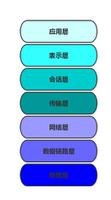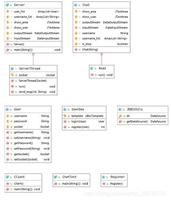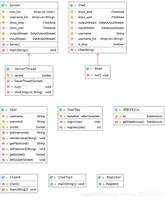java基础知识回顾之java Socket学习(一)--UDP协议编程

UDP传输:面向无连接的协议,不可靠,只是把应用程序传给IP层的数据报包发送出去,不保证发送出去的数据报包能到达目的地。不用再客户端和服务器端建立连接,没有超时重发等机制,传输速度快是它的优点。就像寄信,写好信放到邮箱桶里面,既不能保证信件在邮递过程中不丢失,也不能保证信件是按顺序寄到目的地的。
看java API用到java.net.DatagramSocket和java.net.DatagramPacket类:
DatagramSocket:此类表示用来发送和接收数据报包的套接字(IP地址和端口号)。
DatagramPacket:数据报包用来实现无连接包投递服务。每条报文仅根据该包中包含的信息从一台机器路由到另一台机器。从一台机器发送到另一台机器的多个包可能选择不同的路由,也可能按不同的顺序到达。不对包投递做出保证。
下面看一个简单的接收端和服务端的代码:
接收端代码:
import java.io.IOException;import java.net.DatagramPacket;
import java.net.DatagramSocket;
public class UDPReceDemo {
/**
* @param args
* @throws IOException
*/
public static void main(String[] args) throws IOException {
System.out.println("接收端启动......");
/*
* 建立UDP接收端的思路。
* 1,建立udp socket服务,因为是要接收数据,必须要明确一个端口号。
* 2,创建数据包,用于存储接收到的数据。方便用数据包对象的方法解析这些数据.
* 3,使用socket服务的receive方法将接收的数据存储到数据包中。
* 4,通过数据包的方法解析数据包中的数据。
* 5,关闭资源
*/
//1,建立udp socket服务。
DatagramSocket ds = new DatagramSocket(10000);//接受端应用程序的端口号
//2,创建数据包,用来接收长度为length的数据包
byte[] buf = new byte[1024];
DatagramPacket dp = new DatagramPacket(buf,buf.length);
//3,使用接收方法将数据存储到数据包中。
ds.receive(dp);//阻塞式的。
//4,通过数据包对象的方法,解析其中的数据,比如,地址,端口,数据内容。
String ip = dp.getAddress().getHostAddress();
int port = dp.getPort();//返回主机的端口号
String text = new String(dp.getData(),0,dp.getLength());
System.out.println(ip+":"+port+":"+text);
//5,关闭资源。
ds.close();
}
}
发送端代码:
import java.io.IOException;import java.net.DatagramPacket;
import java.net.DatagramSocket;
import java.net.InetAddress;
public class UDPSendDemo {
/**
* @param args
* @throws IOException
*/
public static void main(String[] args) throws IOException {
System.out.println("发送端启动......");
/*
* 创建UDP传输的发送端。
* 思路:
* 1,建立udp的socket服务。
* 2,将要发送的数据封装到数据报包中。
* 3,通过udp的socket服务将数据包发送出去。
* 4,关闭socket服务。
*/
//1,udpsocket服务。使用DatagramSocket对象。
DatagramSocket ds = new DatagramSocket();
//2,将要发送的数据封装到数据包中。
String str = "udp传输。。。。。。。。。。。。";
//使用DatagramPacket将数据封装到的该对象包中。
byte[] buf = str.getBytes();
//DatagramPacket 包含的信息指示:将要发送的数据、其长度、远程主机的 IP 地址和远程主机的端口号。
DatagramPacket dp =
new DatagramPacket(buf,buf.length,InetAddress.getByName("QT-201216220606"),10000);
//3,通过up的socket服务将数据报发送出去。使用send方法。
ds.send(dp);
//4,关闭资源。
ds.close();
}
}
接收端启动,然后发送端启动,结果发送端向接收端主机发送了:192.168.0.101:4882:udp传输。。。。。。。。。。。。内容。
其它不变,发送端的代码改变,变为可以实现键盘的输入(UDP协议):
package cn.itcast.net.p2.udp;import java.io.BufferedReader;
import java.io.IOException;
import java.io.InputStreamReader;
import java.net.DatagramPacket;
import java.net.DatagramSocket;
import java.net.InetAddress;
public class UDPSendDemo2 {
/**
* @param args
* @throws IOException
*/
public static void main(String[] args) throws IOException {
System.out.println("发送端启动......");
/*
* 创建UDP传输的发送端。
* 思路:
* 1,建立udp的socket服务。
* 2,将要发送的数据封装到数据包中。
* 3,通过udp的socket服务将数据包发送出去。
* 4,关闭socket服务。
*/
//1,udpsocket服务。使用DatagramSocket对象。
DatagramSocket ds = new DatagramSocket();
//键盘输入的内容发送给客户端,使用字节向字符转化的流
BufferedReader bufr = new BufferedReader(new InputStreamReader(System.in));
String line = null;
while((line=bufr.readLine())!=null){
byte[] buf = line.getBytes();
DatagramPacket dp =
new DatagramPacket(buf,buf.length,InetAddress.getByName("192.168.0.101"),10000);
ds.send(dp);
if("over".equals(line))
break;
}
//4,关闭资源。
ds.close();
}
}
启动接收端,启动服务端,在服务端输入,在接收端收到信息。。。。。。。简单的多人聊天室实现:使用多线程,IO:
接收端:
import java.net.DatagramPacket;import java.net.DatagramSocket;
public class Rece implements Runnable {
private DatagramSocket ds;
public Rece(DatagramSocket ds) {
this.ds = ds;
}
@Override
public void run() {
try {
while (true) {
// 2,创建数据包。
byte[] buf = new byte[1024];
DatagramPacket dp = new DatagramPacket(buf, buf.length);
// 3,使用接收方法将数据存储到数据包中。
ds.receive(dp);// 阻塞式的。
// 4,通过数据包对象的方法,解析其中的数据,比如,地址,端口,数据内容。
String ip = dp.getAddress().getHostAddress();
int port = dp.getPort();
String text = new String(dp.getData(), 0, dp.getLength());
System.out.println(ip + "::" + text);
if(text.equals("over")){
System.out.println(ip+"....退出聊天室");
}
}
} catch (Exception e) {
}
}
}
服务端:
package cn.itcast.net.p3.chat;import java.io.BufferedReader;
import java.io.InputStreamReader;
import java.net.DatagramPacket;
import java.net.DatagramSocket;
import java.net.InetAddress;
public class Send implements Runnable {
private DatagramSocket ds;
public Send(DatagramSocket ds){
this.ds = ds;
}
@Override
public void run() {
try {
BufferedReader bufr = new BufferedReader(new InputStreamReader(System.in));
String line = null;
while((line=bufr.readLine())!=null){
byte[] buf = line.getBytes();
//表示把信息发送到192.168.0所有的IP地址上面,发送了一个广播IP地址最后一位1-254的所有主机都能收到
DatagramPacket dp =
new DatagramPacket(buf,buf.length,InetAddress.getByName("192.168.0.255"),10001);
ds.send(dp);
if("886".equals(line))
break;
}
ds.close();
} catch (Exception e) {
}
}
}
启动程序:
import java.io.IOException;import java.net.DatagramSocket;
public class ChatDemo {
/**
* @param args
* @throws IOException
*/
public static void main(String[] args) throws IOException {
DatagramSocket send = new DatagramSocket();
DatagramSocket rece = new DatagramSocket(10001);
new Thread(new Send(send)).start();
new Thread(new Rece(rece)).start();
}
}
以上是 java基础知识回顾之java Socket学习(一)--UDP协议编程 的全部内容, 来源链接: utcz.com/z/390587.html






